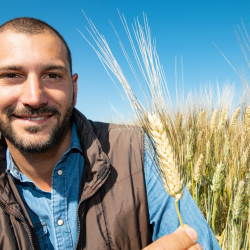Farmers voice sometimes are heard: Jabal variety is out!
Published on: February 7, 2023, Submitted by Filippo Maria Bassi on: January 30, 2023
Jabal is a durum wheat variety obtained from crossing to a wild grass collected in Syria, that risked many times to never see the end of the tunnel, but in February 2022 it was finally released for cultivation in Morocco. This climate-change-resistant variety adapted well to various environmental conditions, particularly in drought-prone areas of Morocco, and provided a significant yield advantage in farmers' fields.
A new drought-tolerant variety of durum wheat named Jabal has been released for cultivation Morocco
It all started with a collection mission organized by the International Centre for Agricultural Research in the Dry Areas (ICARDA) genebank team some 35 years ago. That team traveled to remote high plateaus in Syria searching for unique plants capable of withstanding the very harsh drought conditions common of those areas. Somewhere there, hidden under a stone, proudly showing its filled grains despite the aridity of the land, was a plant of grass, called Aegilops Speltoides. That team of treasure hunters carefully collected its seeds, hoping that one day these would help farms tolerate drought.
That dream remained in a drawer for nearly two decades, as ICARDA genebank continued to collect and identify new and unique germplasm. In 2004, after an inspiring conversation between two friends sitting at a coffee in Aleppo discussing the severe drought that was afflicting Syrian farmers, Dr Ahmed Amri, director of the ICARDA genebank, went back to recover that one strain that had marked him so much when he had moved aside that stone 20 years before. With great care, it planted and nourished those seeds until they generated pollen. He then brought that pollen to the flowering spikes of the very same Syrian variety (Cham 3) that was suffering from drought in the farms. A month later, few hybrid seeds were produced, holding in their DNA the makeup of the variety and that of the wild grass. Through a process called embryo rescues, these were made to germinate and produce pollen again. This time, this hybrid pollen was added to another Syrian variety (Cham 5), which instead it was doing quite well in tolerating the drought.
Progenies of this triple hybrid, containing two Syrian varieties and one wild grass, were planted the following years in the ICARDA research station of Tel Hadya. The ICARDA durum wheat breeder, Dr Miloudi Nachit, selected season after season the best progenies coming from this cross, until one day he realized that the work was done and he was holding in its hands a very promising new variety.
In 2010, another drought hit, but this time it was Morocco to suffer. Dr Nsrellah Nsrellhaq, was walking his field searching for good durum lines capable of withstanding that devastating drought that was wasting his country, and in there it was standing proud that new hybrid that his good friend Dr Nachit had sent him.
Little did he know that two years later Dr Nachit and Dr Amri would rejoin him in Morocco to escape the civil unrest in Syria. So, for the first time in nearly 30 years, since their professional careers had sent them their separate ways, the three old time friends were together again, planting their best lines in the research station of Marchouch, Morocco. Imagine the joy when Dr Nachit and Dr Amri realized that their hybrid, fruit of so much tribulation and vision, was not lost to the civil unrest of Syria, but instead it was proudly displayed for its great tolerance to drought.
In reality, that is where our story could have ended, with the joy of three colleagues that unfortunately never materializes into a real impact in farmers lives. In fact, after few more years of testing to make sure that this hybrid was really performing, all three colleagues reached the end of their brilliant careers and retired. The hybrid was never released as a variety because its performances under drought were outstanding, but when a good year occurred it was not as performing as others. This grain of vision became slowly less interesting in favor of other more novel things, and its story nearly ended in 2016. At that time, it had been used extensively as parents for new crosses and it was even sent to partners in over 30 countries as part of the international nursery of ICARDA, but it had been retired from the trials seeking new varieties for Morocco.
However, the three friends knew better, and in 2013, as a new young recruit was brought to ICARDA to support the work of the durum team they decided to see if the hybrid story could be continued. Dr Bassi came with his degree from North Dakota State University, where he had learned as many other students like him that using wild relatives in breeding was a “last resource”, an approach that only the most audacious of scientists used when no other options remained. That is why the three friends gave him the hybrid, and several other lines like it, but did not tell him that it was derived from wild relatives. Two years later, after he was told his origin, he was conquered too, and the story went on.
In 2017, his excitement for that great hybrid affected another believer in wild relatives, Dr Kilian. During a workshop held in Morocco, the story of that hybrid was told in front of many board members of the Global Crop Diversity Trust (GCDT). In an instant, they decided to invest in it and started a three years project to engage farmers and see their reactions. A participatory approach was used by planting some of the best hybrids directly in farmers hands and gather their inputs.
One of these farmers asked to the team of scientists “what is the name of this beautiful line?” but nobody could reply, since the hybrid had not been named. So, the question was returned to the farmer: “what would you call it?”. He said: “Jabal, as it is strong and proud like the Atlas Mountains, and its spike is black like an ancestral variety that my family used to cultivate there”. So the name was given.
For two years the research team tested Jabal across sites, and for two years the climate decided to make its life very difficult, throwing it at severe droughts and after droughts. When drought hit hard, the commercial varieties would suffer and wither, while Jabal remained good, strong of its wild genes adapted to survive the harsh remote plateaus of Syria. When farmers were asked to place a stone next to their preferred lines, piles of stones were always posed in front of Jabal, quickly becoming the preferred of all (link). When prompted to explain, they would say that the black spike was so beautiful that they wanted their fields to be full of it. Others would say, because it is a bit taller, I can get so much more straw for my animals, and that is more important to me than anything else. Still, probably the one reason that really convinced many was its taste. “When my wife makes bread with it, I can smell it from miles away” one of them said, and all heads around started moving up and down.
So Jabal adapted well to drought, produced more straw for feeding livestock, had a beautiful black spike, and it tasted great. Maybe surprisingly for some, but none of these are characteristics for which the variety release committee tests for. So, most of the breeders thought it not wort releasing, and for some times Jabal story was getting close to end, again.
That is when the last two characters of this novel stepped up, one is a large farmer named Mr Benchaib and the second a retired breeder Dr Jlibene. When they had seen this beautiful line in the field of their own drought-torn farm they could not believe how good it was. But it was only after they heard how much passion it inspired in farmers that they took the decision to present it to the Moroccan catalogue of varieties. Two years of testing later, the committee was unsured if to confirm it for release. It had done well for many of the tests, but not for all. It is then that Dr Jlibene told the committee of the great appreciation by farmers, and so the decision was taken.
In February 2022, the Ministry of Agriculture of Morocco officially registered Jabal for cultivation, 40 years after the original strain of Aegilops speltoides was collected in Syria, 18 years after the hybrid was produced by Dr Amri, 12 years after Dr Nachit had provided it to his Moroccan colleague for trialing, 8 years after Dr Bassi was tricked into liking it, 4 years after the GCDT invested in promoting its use, and 2 years after the Moroccan farmers requested it for cultivation.
Photo of the new released variety Jabal in field. Photo: Michael Major/crop Trust
Long as it might be, the story of Jabal is not finished yet. Four more years will be needed for multiplication to become available for farmers to use, and probably as many before farmers in all drought affected zones of Morocco can finally get seeds of it. Still, one big step has been taken today and the path now lies open to fulfill the farmers hope and to match the dream of that team that went lifting a rock in the plateaus of Syria.
Photos of spikes and grain of the newly released variety Jabal.
Acknowledgement
This work was undertaken as part of the initiative “Adapting Agriculture to Climate Change: Collecting, Protecting and Preparing CropWild Relatives, supported by the Government of Norway, managed by the Global Crop Diversity Trust with the Millennium Seed Bank of the Royal Botanic Gardens” under BOLD (Biodiversity for Opportunities, Livelihoods and Development).


